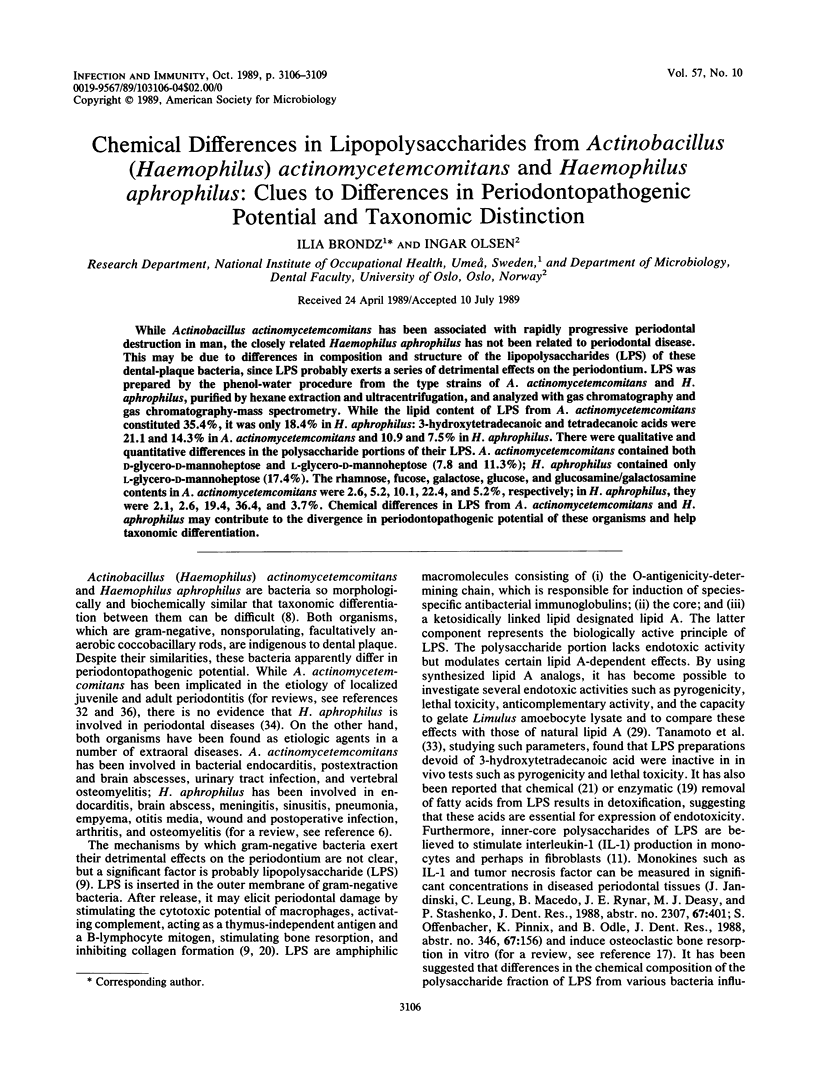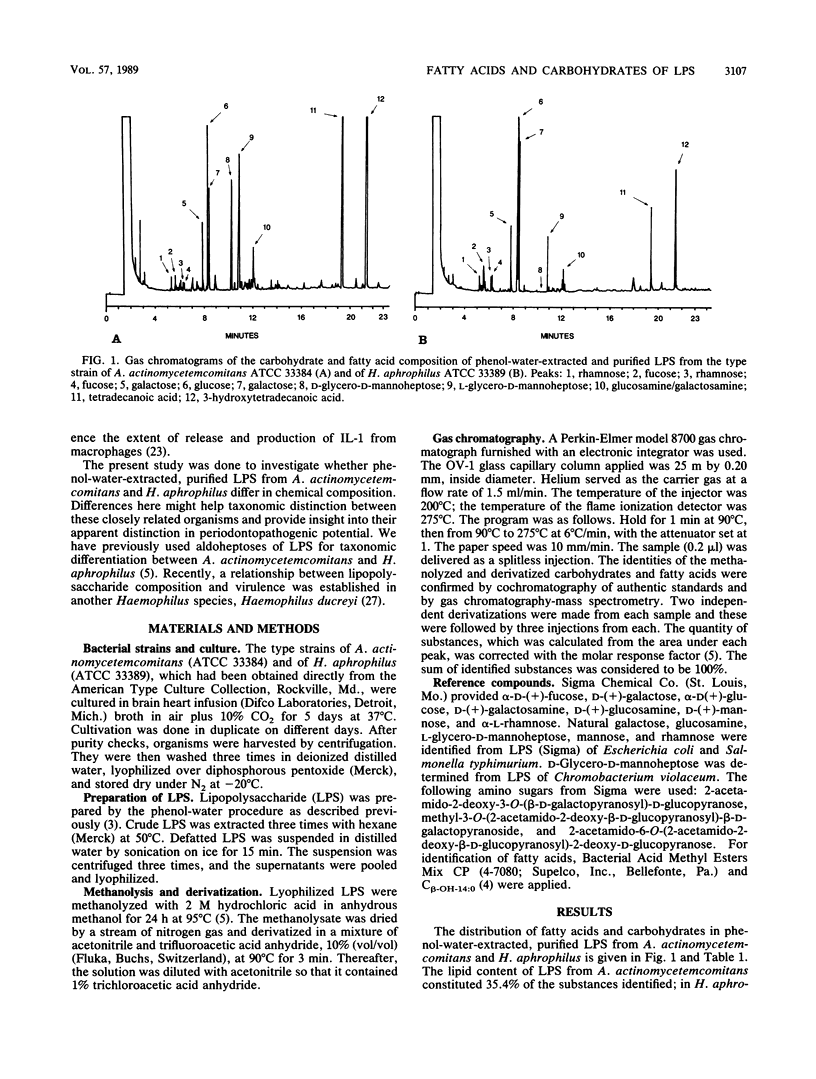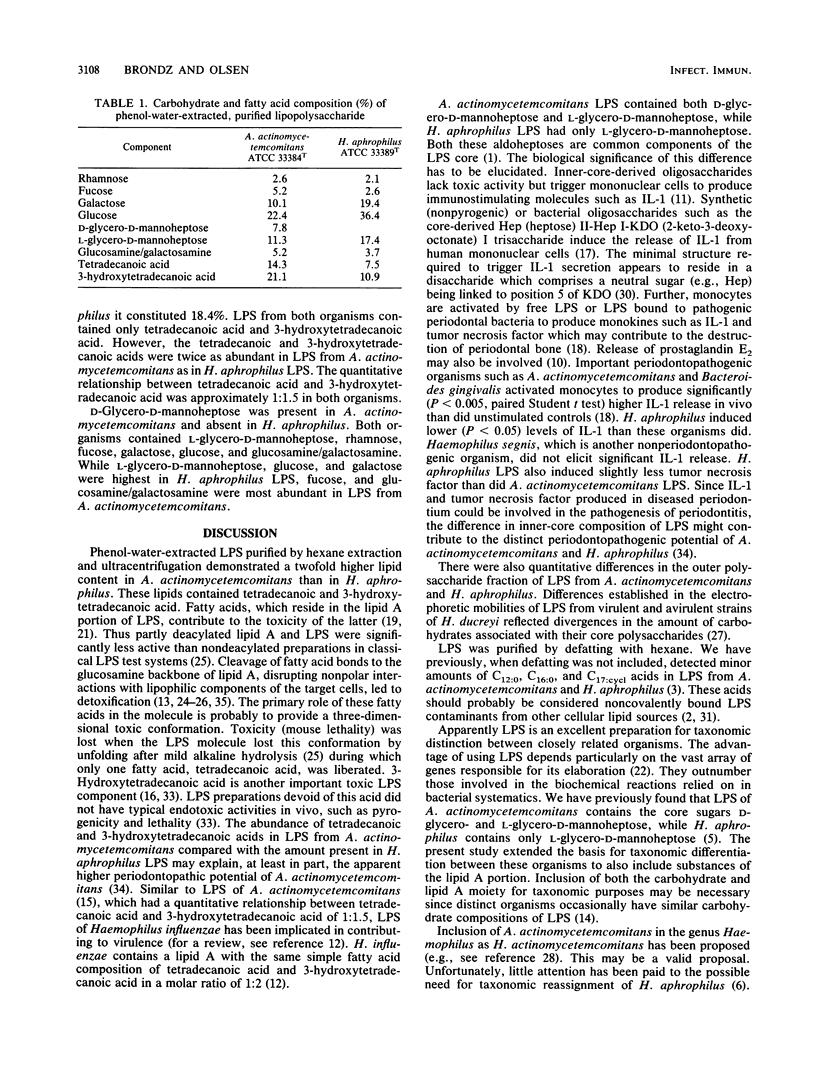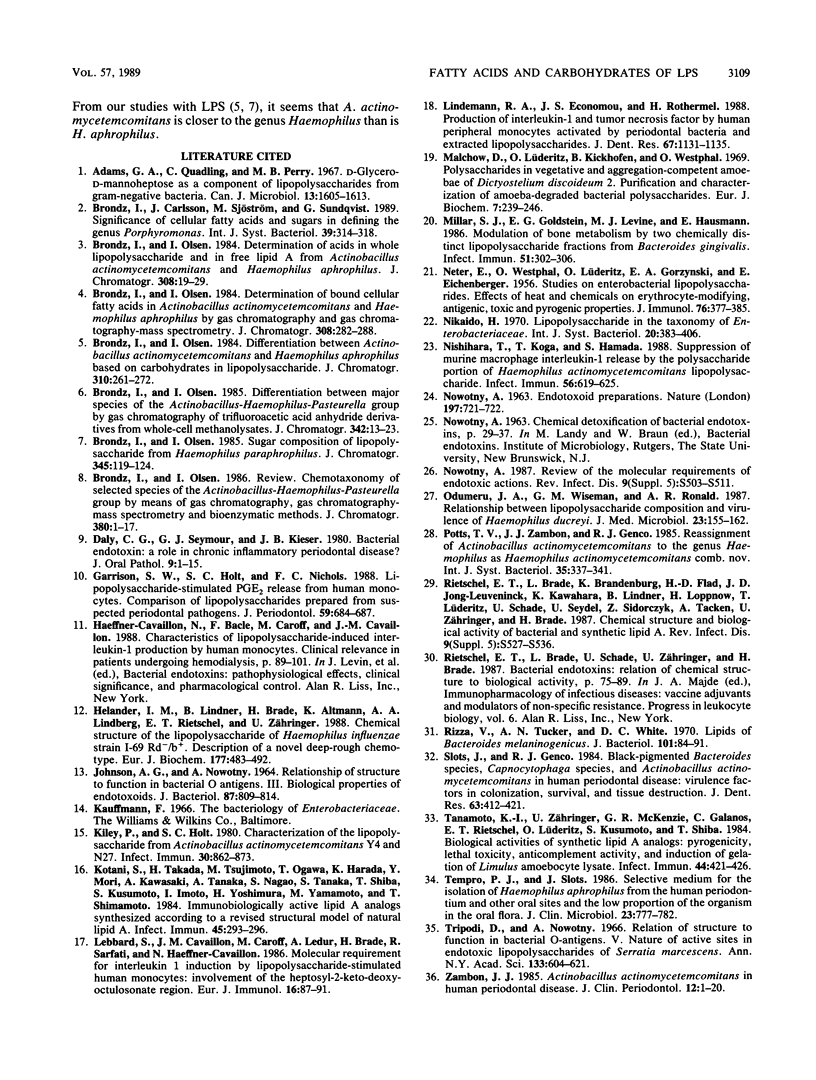Abstract
While Actinobacillus actinomycetemcomitans has been associated with rapidly progressive periodontal destruction in man, the closely related Haemophilus aphrophilus has not been related to periodontal disease. This may be due to differences in composition and structure of the lipopolysaccharides (LPS) of these dental-plaque bacteria, since LPS probably exerts a series of detrimental effects on the periodontium. LPS was prepared by the phenol-water procedure from the type strains of A. actinomycetemcomitans and H. aphrophilus, purified by hexane extraction and ultracentrifugation, and analyzed with gas chromatography and gas chromatography-mass spectrometry. While the lipid content of LPS from A. actinomycetemcomitans constituted 35.4%, it was only 18.4% in H. aphrophilus: 3-hydroxytetradecanoic and tetradecanoic acids were 21.1 and 14.3% in A. actinomycetemcomitans and 10.9 and 7.5% in H. aphrophilus. There were qualitative and quantitative differences in the polysaccharide portions of their LPS. A actinomycetemcomitans contained both D-glycero-D-mannoheptose and L-glycero-D-mannoheptose (7.8 and 11.3%); H. aphrophilus contained only L-glycero-D-mannoheptose (17.4%). The rhamnose, fucose, galactose, glucose, and glucosamine/galactosamine contents in A. actinomycetemcomitans were 2.6, 5.2, 10.1, 22.4, and 5.2%, respectively; in H. aphrophilus, they were 2.1, 2.6, 19.4, 36.4, and 3.7%. Chemical differences in LPS from A. actinomycetemcomitans and H. aphrophilus may contribute to the divergence in periodontopathogenic potential of these organisms and help taxonomic differentiation.
Full text
PDF



Selected References
These references are in PubMed. This may not be the complete list of references from this article.
- Adams G. A., Quadling C., Perry M. B. D-glycero-D-manno-heptose as a component of lipopolysaccharides from Gram-negative bacteria. Can J Microbiol. 1967 Dec;13(12):1605–1613. doi: 10.1139/m67-210. [DOI] [PubMed] [Google Scholar]
- Brondz I., Olsen I. Chemotaxonomy of selected species of the Actinobacillus-Haemophilus-Pasteurella group by means of gas chromatography, gas chromatography-mass spectrometry and bioenzymatic methods. J Chromatogr. 1986 Jul 11;380(1):1–17. [PubMed] [Google Scholar]
- Brondz I., Olsen I. Determination of acids in whole lipopolysaccharide and in free lipid A from Actinobacillus actinomycetemcomitans and Haemophilus aphrophilus. J Chromatogr. 1984 Jun 8;308:19–29. doi: 10.1016/s0021-9673(01)87529-4. [DOI] [PubMed] [Google Scholar]
- Brondz I., Olsen I. Determination of bound cellular fatty acids in Actinobacillus actinomycetemcomitans and Haemophilus aphrophilus by gas chromatography and gas chromatography-mass spectrometry. J Chromatogr. 1984 Jun 8;308:282–288. doi: 10.1016/s0021-9673(01)87554-3. [DOI] [PubMed] [Google Scholar]
- Brondz I., Olsen I. Differentiation between Actinobacillus actinomycetemcomitans and Haemophilus aphrophilus based on carbohydrates in lipopolysaccharide. J Chromatogr. 1984 Oct 12;310(2):261–272. doi: 10.1016/0378-4347(84)80091-2. [DOI] [PubMed] [Google Scholar]
- Brondz I., Olsen I. Differentiation between major species of the Actinobacillus--Haemophilus--Pasteurella group by gas chromatography of trifluoroacetic acid anhydride derivatives from whole-cell methanolysates. J Chromatogr. 1985 Jul 12;342(1):13–23. doi: 10.1016/s0378-4347(00)84485-0. [DOI] [PubMed] [Google Scholar]
- Brondz I., Olsen I. Sugar composition of lipopolysaccharide from Haemophilus paraphrophilus. J Chromatogr. 1985 Nov 29;345(1):119–124. doi: 10.1016/0378-4347(85)80141-9. [DOI] [PubMed] [Google Scholar]
- Daly C. G., Seymour G. J., Kieser J. B. Bacterial endotoxin: a role in chronic inflammatory periodontal disease? J Oral Pathol. 1980 Jan;9(1):1–15. doi: 10.1111/j.1600-0714.1980.tb01383.x. [DOI] [PubMed] [Google Scholar]
- Garrison S. W., Holt S. C., Nichols F. C. Lipopolysaccharide-stimulated PGE2 release from human monocytes. Comparison of lipopolysaccharides prepared from suspected periodontal pathogens. J Periodontol. 1988 Oct;59(10):684–687. doi: 10.1902/jop.1988.59.10.684. [DOI] [PubMed] [Google Scholar]
- Haeffner-Cavaillon N., Bacle F., Caroff M., Cavaillon J. M. Characteristics of lipopolysaccharide-induced interleukin-1 production by human monocytes. Clinical relevance in patients undergoing hemodialysis. Prog Clin Biol Res. 1988;272:89–101. [PubMed] [Google Scholar]
- Helander I. M., Lindner B., Brade H., Altmann K., Lindberg A. A., Rietschel E. T., Zähringer U. Chemical structure of the lipopolysaccharide of Haemophilus influenzae strain I-69 Rd-/b+. Description of a novel deep-rough chemotype. Eur J Biochem. 1988 Nov 15;177(3):483–492. doi: 10.1111/j.1432-1033.1988.tb14398.x. [DOI] [PubMed] [Google Scholar]
- JOHNSON A. G., NOWOTNY A. RELATIONSHIP OF STRUCTURE TO FUNCTION IN BACTERIAL O ANTIGENS. III. BIOLOGICAL PROPERTIES OF ENDOTOXOIDS. J Bacteriol. 1964 Apr;87:809–814. doi: 10.1128/jb.87.4.809-814.1964. [DOI] [PMC free article] [PubMed] [Google Scholar]
- Kiley P., Holt S. C. Characterization of the lipopolysaccharide from Actinobacillus actinomycetemcomitans Y4 and N27. Infect Immun. 1980 Dec;30(3):862–873. doi: 10.1128/iai.30.3.862-873.1980. [DOI] [PMC free article] [PubMed] [Google Scholar]
- Kotani S., Takada H., Tsujimoto M., Ogawa T., Harada K., Mori Y., Kawasaki A., Tanaka A., Nagao S., Tanaka S. Immunobiologically active lipid A analogs synthesized according to a revised structural model of natural lipid A. Infect Immun. 1984 Jul;45(1):293–296. doi: 10.1128/iai.45.1.293-296.1984. [DOI] [PMC free article] [PubMed] [Google Scholar]
- Lebbar S., Cavaillon J. M., Caroff M., Ledur A., Brade H., Sarfati R., Haeffner-Cavaillon N. Molecular requirement for interleukin 1 induction by lipopolysaccharide-stimulated human monocytes: involvement of the heptosyl-2-keto-3-deoxyoctulosonate region. Eur J Immunol. 1986 Jan;16(1):87–91. doi: 10.1002/eji.1830160117. [DOI] [PubMed] [Google Scholar]
- Lindemann R. A., Economou J. S., Rothermel H. Production of interleukin-1 and tumor necrosis factor by human peripheral monocytes activated by periodontal bacteria and extracted lipopolysaccharides. J Dent Res. 1988 Aug;67(8):1131–1135. doi: 10.1177/00220345880670081401. [DOI] [PubMed] [Google Scholar]
- Malchow D., Lüderitz O., Kickhöfen B., Westphal O., Gerisch G. Polysaccharides in vegetative and aggregation-competent amoebae of Dictyostelium discoideum. 2. Purification and characterization of amoeba-degraded bacterial polysaccharides. Eur J Biochem. 1969 Jan;7(2):239–246. doi: 10.1111/j.1432-1033.1969.tb19598.x. [DOI] [PubMed] [Google Scholar]
- Millar S. J., Goldstein E. G., Levine M. J., Hausmann E. Modulation of bone metabolism by two chemically distinct lipopolysaccharide fractions from Bacteroides gingivalis. Infect Immun. 1986 Jan;51(1):302–306. doi: 10.1128/iai.51.1.302-306.1986. [DOI] [PMC free article] [PubMed] [Google Scholar]
- NETER E., WESTPHAL O., LUDERITZ O., GORZYNSKI E. A., EICHENBERGER E. Studies of enterobacterial lipopolysaccharides; effects of heat and chemicals on erythrocyte-modifying, antigenic, toxic and pyrogenic properties. J Immunol. 1956 May;76(5):377–385. [PubMed] [Google Scholar]
- NOWOTNY A. Endotoxoid preparations. Nature. 1963 Feb 16;197:721–722. doi: 10.1038/197721b0. [DOI] [PubMed] [Google Scholar]
- Nishihara T., Koga T., Hamada S. Suppression of murine macrophage interleukin-1 release by the polysaccharide portion of Haemophilus actinomycetemcomitans lipopolysaccharide. Infect Immun. 1988 Mar;56(3):619–625. doi: 10.1128/iai.56.3.619-625.1988. [DOI] [PMC free article] [PubMed] [Google Scholar]
- Nowotny A. Review of the molecular requirements of endotoxic actions. Rev Infect Dis. 1987 Sep-Oct;9 (Suppl 5):S503–S511. doi: 10.1093/clinids/9.supplement_5.s503. [DOI] [PubMed] [Google Scholar]
- Odumeru J. A., Wiseman G. M., Ronald A. R. Relationship between lipopolysaccharide composition and virulence of Haemophilus ducreyi. J Med Microbiol. 1987 Mar;23(2):155–162. doi: 10.1099/00222615-23-2-155. [DOI] [PubMed] [Google Scholar]
- Rietschel E. T., Brade L., Brandenburg K., Flad H. D., de Jong-Leuveninck J., Kawahara K., Lindner B., Loppnow H., Lüderitz T., Schade U. Chemical structure and biologic activity of bacterial and synthetic lipid A. Rev Infect Dis. 1987 Sep-Oct;9 (Suppl 5):S527–S536. doi: 10.1093/clinids/9.supplement_5.s527. [DOI] [PubMed] [Google Scholar]
- Rizza V., Tucker A. N., White D. C. Lipids of Bacteroides melaninogenicus. J Bacteriol. 1970 Jan;101(1):84–91. doi: 10.1128/jb.101.1.84-91.1970. [DOI] [PMC free article] [PubMed] [Google Scholar]
- Slots J., Genco R. J. Black-pigmented Bacteroides species, Capnocytophaga species, and Actinobacillus actinomycetemcomitans in human periodontal disease: virulence factors in colonization, survival, and tissue destruction. J Dent Res. 1984 Mar;63(3):412–421. doi: 10.1177/00220345840630031101. [DOI] [PubMed] [Google Scholar]
- Tanamoto K., Zähringer U., McKenzie G. R., Galanos C., Rietschel E. T., Lüderitz O., Kusumoto S., Shiba T. Biological activities of synthetic lipid A analogs: pyrogenicity, lethal toxicity, anticomplement activity, and induction of gelation of Limulus amoebocyte lysate. Infect Immun. 1984 May;44(2):421–426. doi: 10.1128/iai.44.2.421-426.1984. [DOI] [PMC free article] [PubMed] [Google Scholar]
- Tempro P. J., Slots J. Selective medium for the isolation of Haemophilus aphrophilus from the human periodontium and other oral sites and the low proportion of the organism in the oral flora. J Clin Microbiol. 1986 Apr;23(4):777–782. doi: 10.1128/jcm.23.4.777-782.1986. [DOI] [PMC free article] [PubMed] [Google Scholar]
- Tripodi D., Nowotny A. Relation of structure to function in bacterial O-antigens. V. Nature of active sites in endotoxic lipopolysaccharides of Serratia marcescens. Ann N Y Acad Sci. 1966 Jun 30;133(2):604–621. doi: 10.1111/j.1749-6632.1966.tb52392.x. [DOI] [PubMed] [Google Scholar]
- Zambon J. J. Actinobacillus actinomycetemcomitans in human periodontal disease. J Clin Periodontol. 1985 Jan;12(1):1–20. doi: 10.1111/j.1600-051x.1985.tb01348.x. [DOI] [PubMed] [Google Scholar]


